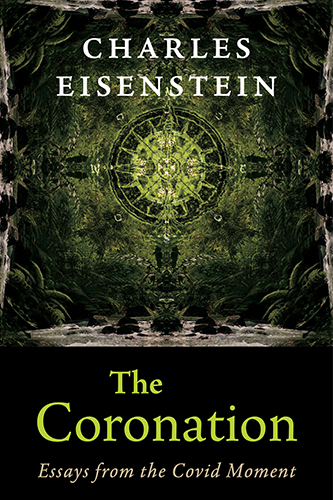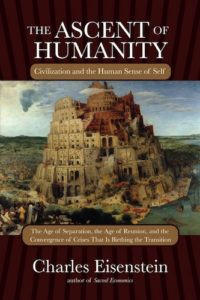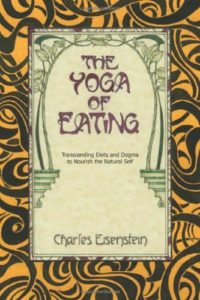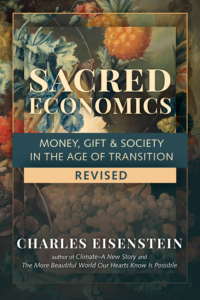Climate — A New Story
Chapters
Chapter 11: An Affair of the Heart
If We Knew She Could Feel
It is not only Western climate catastrophists who warn of a great dying to come. Many indigenous people also see a great peril upon us. Their warning does not invoke rising levels of greenhouse gases; it references another matrix of causality that involves the desecration of life itself. This deeper causal system also suggests a deeper set of responses, all of which come down to holding life and matter sacred again. It offers new hope, an exit from the futility of the endless “fight” against climate change.
It won’t be surprising to anyone who has read chapters 4 and 5 of this book that many of their warnings are on one level simply about ecosystem destruction. Here are the words of the remarkable Yanomami shaman Davi Kopenawa from the book The Falling Sky:
The forest is alive. It can only die if the white people persist in destroying it. If they succeed, the rivers will disappear underground, the soil will crumble, the trees will shrivel up, and the stones will crack in the heat. The dried-up earth will become empty and silent. The xapiri spirits who come down from the mountains to play on their mirrors in the forest will escape far away. Their shaman fathers will no longer be able to call them and make them dance to protect us. They will be powerless to repel the epidemic fumes which devour us. They will no longer be able to hold back the evil beings who will turn the forest to chaos. We will die one after the other, the white people as well as us. All the shamans will finally perish. Then, if none of them survive to hold it up, the sky will fall.[3]
Here Kopenawa expresses a belief widespread among indigenous people: that human activity, including ritual activity, is part of the glue that holds the world together. When we forget our proper function and cease to serve life, the world falls apart.
The tribes of the Colombian Sierra Nevada de Santa Marta (of whom the best known are the Kogi) have a similar belief.[4] They believe that a black line, a network of hidden connections, links all the sacred places on Earth. If that line should be broken, calamities will ensue, and this beautiful world shall perish. Destroying a forest here, draining a swamp there, might have dire consequences across the globe. The shamans cannot perform their work of maintaining the balance of nature much longer in the face of our depredations.
How are we to interpret these warnings?
Several interpretations occur to the Western mind, all unsatisfactory. Most of us would no longer be so crude as to dismiss the warnings as the magico-religious rantings of benighted primitives whom we must awaken from their silly superstitions. Today we have more sophisticated ways to deafen ourselves to their message.
The first we might call “ontological imperialism.” It would be to say, “Yes, the indigenous are onto something after all. The black line is a metaphor for ecological interconnectedness. “Xapiri spirits” is code for the hydrological cycle. The indigenous are keen observers of nature and have articulated scientific truths in their own cultural language.” That sounds fair enough, doesn’t it? It gives them credit for being astute observers of nature. However, this view takes for granted that basal reality is that of scientific materialism, thereby disallowing the conceptual categories and causal understandings of the indigenous. It says that fundamentally, we understand the nature of reality better than they do.
If their message were merely “We must take better care of nature,” then the above understanding would be sufficient. But people like Davi Kopenawa and the Sierra Nevada tribes are inviting us into a much deeper change than that. Do we understand the nature of reality better than they do? It once seemed so, but today the spawn of our supposed understanding—social and ecological crisis—gnaw at our surety.
A second and related form of deafness is what Edward Said called “Orientalism”—the distortion (romanticizing, demonizing, exaggerating, reducing) of another culture to conform it to a comfortable and self-serving narrative. Accordingly, we could turn the Kogi into a kind of cultural or spiritual fetish object, subsuming them into our own cultural mythology, perhaps by making them into an academic subject and stuffing their beliefs and way of life into various ethnographic categories. In that way we make them safe, we make them ours. It is another kind of imperialism.
We might do the same by inserting their messages into a comfortable silo called “indigenous wisdom,” elevating the indigenous to superhuman status—and, in the process, dehumanizing them as well. It is not true respect to worship an image—the reverse image of our own shadow—that we project onto another culture. Real respect seeks to understand someone on their own terms.
The Sierra Nevada tribes are famous today thanks to two films, From the Heart of the World and Aluna.[5] I have always been a little uncomfortable with documentaries about other cultures, because they of necessity objectify their subjects, turning them into the material of a (video) “document.” By documenting them, we incorporate them into our world, into a safe educational or entertainment or inspirational frame, and into the Debordian society of the spectacle. Fortunately, these films are not documentaries.
Who is the filmmaker here? Ordinarily one would say it was Alan Ereira, a former BBC producer who came in with his cameras and crew. But that’s not what Ereira says, and that’s not what the Kogi say either. According to them, the elders noticed the accelerating degradation of the planet and contacted the outside world to deliver a message that we must stop the destruction. They did so first in the early 1990s with From the Heart of the World, after which they again withdrew from contact.
Obviously, we didn’t heed their message. “We must not have spoken it clearly enough,” they concluded, and so they sought out Ereira again to make a sequel. The cynical observer, practiced with the tools of post-colonial analysis, might think that the assertion that “the Kogi have requested this film be made in order to convey their message” is a mere cinematic trope, or a way to preempt charges of exoticism, Orientalism, and cultural appropriation. However, that analysis is itself a kind of colonialism that sees the Kogi patronizingly as the helpless pawns of the filmmaker, and discounts their own explicit assertion that they have called the filmmaker back in order to transmit an important message to “little brother” (us).
Dare we take the Sierra Nevada elders at face value? Dare we hold them in full agency as authors not only of this film, but of a message sent to us on their initiative? To do so reverses the power relations implicit in even the most post-colonially sensitive ethnography, in which the distinction between the ethnographic subject and the ethnographer is usually preserved in some form (and institutionalized when, with all due disclaimers, it appears in academic publications). Anthropologists don’t normally grant ethnographic populations agency as the originators of messages to academia.
In these films, the colonial gaze is turned back on us: sternly, imploringly, and with great love. The elders tell us, “You mutilate the world because you don’t remember the Great Mother. If you don’t stop, the world will die.” Please believe us, they say. You must stop doing this. “Do you think we say these words for the sake of talking? We are speaking the truth.”
Why hasn’t little brother listened? It has been nearly thirty years since the Kogi elders first spoke their message to the modern world. Perhaps we have not listened because we have not yet come to humility. We continue to try to somehow box, contain, and reduce the Kogi and their message so that it can rest comfortably in our existing Story of the World.
In this book I have proposed that our reductive Story of the World underlies the world’s literal reduction: extinction, soil impoverishment, ecosystem collapse, etc. The Kogi offer a similar teaching. They say that thought is the scaffolding of matter; that without thought, nothing could exist. (This is not an anthropocentric view, because they do not consider thought to be merely a product of the human mind. Thought is prior to human beings; our minds are but one of its receivers.) The official Aluna website describes the Kogi’s view thusly: “We are not just plundering the world, we are dumbing it down, destroying both the physical structure and the thought underpinning existence.”
Thankfully, the requisite humility to truly hear the Sierra Nevada elders is fast upon us, born of—what else?—humiliation. As our cultural mythology falls apart, we face repeated humiliation in the failure of our cherished systems of technology, politics, law, medicine, education, and more. Only with increasingly strenuous and willful ignorance can we deny that the grand project of civilization has reached a dead end. We see now that what we do to nature we do to ourselves; that its plunder brings our poverty. The utopian mirage of the technologist and the social engineer recedes ever further into the distance.
The breakdown of our categories and narratives, the breakdown of our Story of the World, gives us the gift of humility. That is the only thing that can open us to receive the teachings of indigenous people—to truly receive them, and not merely insert them into some comfortable silo called “indigenous wisdom,” as if they were a museum piece or a spiritual acquisition.
I am not suggesting that we adopt, part and parcel, indigenous cosmology. We need not imitate their shamanic practices or learn to listen to bubbles in the water. What we must do is embrace the core understanding that motivates the attempt to listen to water in the first place: the understanding that nature is alive and intelligent. Then we will find our own ways of listening.
The Western civilized mind does not easily comprehend the idea of the intelligence of nature except through anthropomorphizing or deifying it—another attempt at conquest.
Granting subjectivity and agency to nature and everything in it does not mean to grant human subjectivity and human agency, making them into storybook versions of us. It means asking “What does the land want?” “What does the river want?” “What does the planet want?”—questions that seem crazy from the perspective of nature-as-thing.
Materialism, however, isn’t what it used to be. Science is evolving, recognizing that nature is composed of interdependent systems within systems within systems, just as a human body is; that soil mycorrhizal networks are as complex as brain tissue; that water can carry information and structure; that the earth and even the sun maintain homeostatic balance just as a body does. We are learning that order, complexity, and organization are fundamental properties of matter, mediated through physical processes that we recognize—and perhaps by others we do not. The excluded spirit is coming back to matter, not from without but from within.
So the question “What does nature want?” does not depend for its coherency on anything supernatural, no external intelligence. The wanting is an organic process, an entelechy born of relationship, a movement toward an unfolding wholeness.
In that understanding, we can no longer cut down forests and drain swamps, dam rivers and fragment ecosystems with roads, dig pit mines and drill gas wells, with impunity. The Kogi say that to do so damages the whole body of nature, just as if you cut off a person’s limb or removed an organ. The well-being of all depends on the well-being of each. We cannot cut down one forest here and plant another there, assuring ourselves through the calculus of net CO2 that we have done no damage. How do we know we have not removed an organ? How do we know we have not destroyed what the Kogi call an esuana—a key node on the black thread scaffolding the natural world? How do we know we have not destroyed a sacred tree, what the Kogi call “the father of the species,” upon which the whole species depends?
Until we can know it, we’d best refrain from committing further ecocide on any scale. Each intact estuary, river, forest, and wetlands that remains to us, we must treat as sacred, while restoring whatever we can. Davi Kopenawa and the Sierra Nevada elders agree: we are close to the dying of the world. This warning does not contradict the possibility I raised in chapter 7, that humanity might yet survive in a ruined world, a concrete world, a dead world. The world might die and yet we might live.
Science is beginning to recognize what many cultures have always known. An invisible web of causality does indeed connect every place on Earth. Building a road that cuts off the natural water flow at a key site might initiate a cascade of changes—more evaporation, salinization, vegetation die-off, flooding, drought—that have far-reaching effects. We must understand that as exemplifying a general principle of interconnectedness and aliveness. Otherwise, we are left only with the logic of instrumental utilitarianism as reason to protect nature—save the rainforest because of its value to us. But that mindset is part of the problem. We need more love, not more self-interest. We know it is wrong to exploit another person for our own gain, because another person is a full subject with her own feelings, desires, pain, and joy. If we knew that nature too were a full subject, we would stop ravaging her as well. As an elder says in Aluna, “If you knew she could feel, you would stop.”
If you knew she could feel, you would stop. Isn’t it obvious too, that as long as we don’t know she can feel, we will never stop? Isn’t it obvious that we need a Story of the World that helps us to know that she can feel?
End Notes
[3] From the preface to Kopenawa and Albert (2013).
[4] The other tribes are the Arhuaco (or Ika), Wiwa, and Kankuamo. Of these, the Kankuamo are largely assimilated. The Arhuaco are politically active in the movement to protect indigenous rights, while the Kogi have retreated up the mountain to minimize contact and protect their culture. All have suffered at the hands of coca growers, paramilitaries, land developers, and so forth. In this section I will usually refer to the Kogi, although much of what I say is also true of the other tribes.
[5] This section was adapted from a review of Aluna that I wrote for Tikkun magazine: “Aluna: A Message to Little Brother” (Eisenstein, 2015a).






